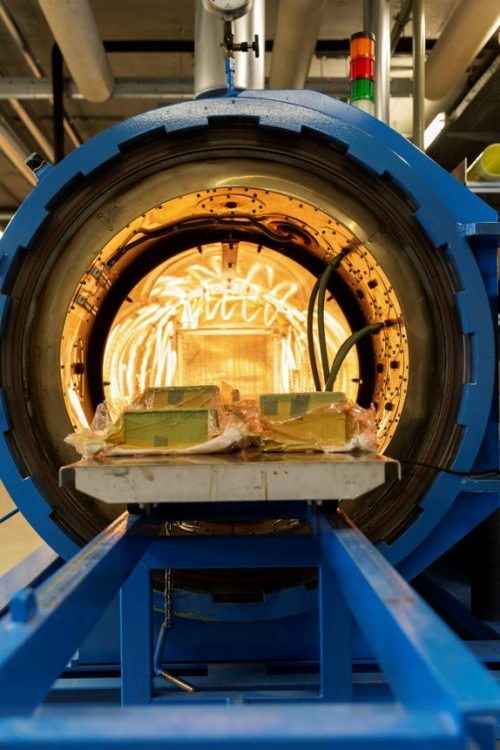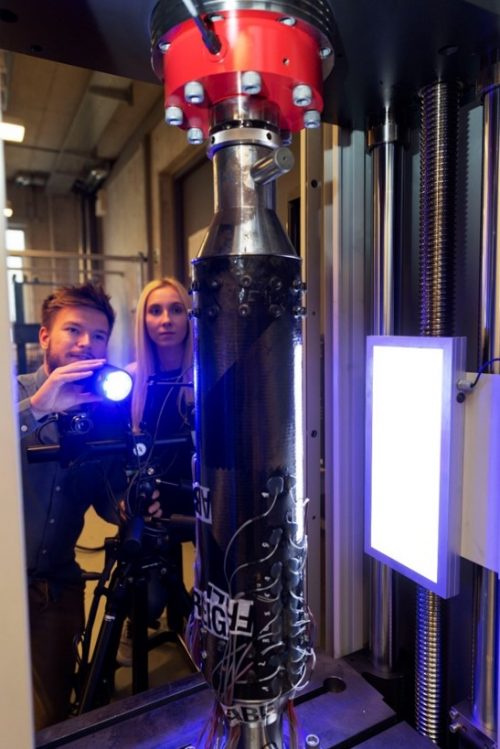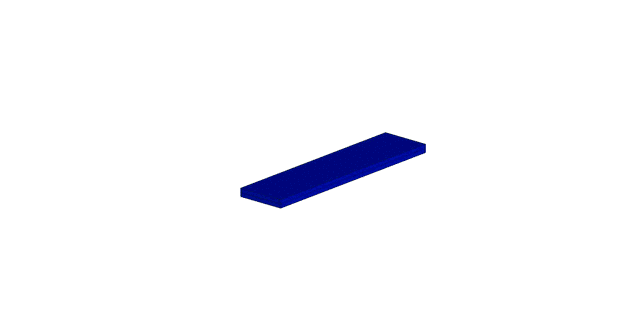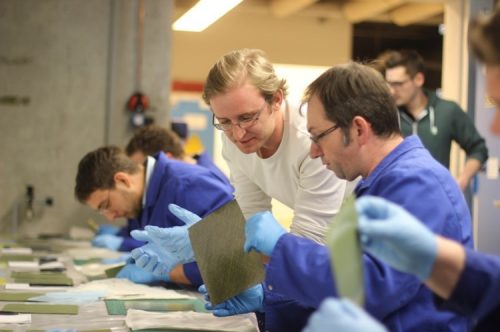
Leichtbau
Das Labor für Faserverbundtechnik (LFT) der Fakultät Maschinenbau an der OTH Regensburg konnte bereits in zahlreichen Forschungs- und Entwicklungsaufträgen, sowie bei Schadensanalysen für die Wirtschaft das Wissen aus der Lehre und Forschung in die Praxis transportieren, um den Unternehmen einen Entwicklungs- und Wettbewerbsvorteil zu bieten. Diese Erfahrung und Praxis wird nun in den Technologie Campus Neustadt an der Donau eingebracht und erweitert.
Neben der Auslegung klassischer isotroper Werkstoffe und Systeme im Sinne des System- und Strukturleichtbau durch u. a. Topologie-Optimierungen und Funktionsintegrationen widmet sich der Bereich Leichtbau vor allem dem Stoffleichtbau.
Vor allem faserverstärkte Kunststoffe (FVK) zeichnen sich im technischen Bereich durch ihre sehr guten spezifischen Steifigkeiten und Festigkeiten aus. Neben dem meist bekannten kohlenstofffaserverstärkten Kunststoff, auch CFK oder umgangssprachlich nur Carbon genannt, sind vor allem Glasfaser-, Aramidfaser- oder auch Basaltfaserverbunde weitere technisch interessante Beispiele von faserverstärkten Werkstoffen. Nicht nur die Gewichtsoptimierung sondern weitere Materialeigenschaften wie die Einstellbarkeit der elektrischen Eigenschaften, die elastischen Eigenschaften oder die Beständigkeiten gegenüber Medien und Alterung sind einige Punkte für die Anwendung solcher Materialien.
Dem Einsatz gegenüber stehen häufig Unsicherheiten in Bezug auf die Kosten und den Aufwand in der Herstellung und Verwendung solcher Werkstoffe. Auch die wenig verbreitete Kenntnis zum fasergerechten Konstruieren und Fertigen spielt in dieser Hinsicht eine Rolle.
Aufgabenfelder
Leistungen

Fertigungsverfahren
- Heißluftautoklavtechnik mit und ohne Prepreg-Systemen
- Vakuuminfusion- und Handlaminierverfahren mit unterschiedlichen Oberflächeneigenschaften
- Wickelverfahren mit eigenen Anlagen für duroplastische und thermoplastische Matrixsysteme
- 3D-Druckverfahren auf Basis des FDM- und SLA-Verfahrens mit und ohne Faserverstärkung in Kurz-, Lang- und Endlosform
Technische Entwicklung/Konstruktion
- Problemanalyse mit Ausarbeitung der Anforderungen
- Erarbeitung von Prinziplösungen und -ideen
- Konzepterstellung mit skizzierten Entwürfen
- Auslegung und Berechnung des Entwurfs
- Ausarbeitung in CAD-Programmen
- Zeichnungsableitung und Fertigungsbegleitung
Bauteilversuch
- Versuchsplanung mit Beachtung der Anforderungen
- Vorrichtungsbau zur Adaption von Krafteinleitung und Befestigung
- Auslegung und Anbringung der Messtechnik (DMS, DIC, etc.)
- Durchführung der Versuche unter Laborbedingungen
- Aufbereitung und Auswertung der Messdaten
Werkstoff- und Materialanalyse
- Kennwertermittlungen
- Festigkeitsprüfungen
- Zug-, Druck-, Biege- und Schublast
- Ultraschallprüfung
- Mikroskopie
- Faser- und Porenvolumengehaltsbestimmung
- Frequenz- und Schwingungsverhalten
- Thermisches Verhalten



Berechnung und Simulation
- Auslegung von Baugruppen, Bauteilen und Werkstoffen
- Festigkeitsnachweis eizelner Bauteile oder Werkstoffe mit Kennwertermittlung
- Analytische Modelle von Teilsystemen wie Bögen, Rohre oder Platten
- Klassische Berechnung von FVK anhand von Laminattheorien
- Numerische Abbildung von FVK in mechanischen Analysen
- Zyklische Bauteilbelastungen im Sinne von Fatigue und Lebensdauerberechnung
Beratung und Dienstleistung
- Prozess- und Schadensanalyse
- Berechnungs- und Fertigungsberatung
- Fachvorträge in Unternehmen
- Seminare und Schulungen der Industrie
Materialien und Fragestellungen
Materialien
- Stahl- und Aluminiumlegierungen aus diversen Herstellungsprozessen
- Thermoplastische und Duroplastische Kunststoffe
- Kurz- und Langfaserverstärkte Kunststoffe
- Endlosfaserverstärkte Kunststoffe mit Fasern aus Glas, Kohlenstoff, Basalt oder Aramid und beliebiger Kunststoffmatrix
Typische Fragen
- Welche Ausgangsmaterialien an Faser- und Kunststoff benötige ich für die vorhandenen Anforderungen?
- Welche Bauteildimensionen, Faserorientierungen und Lagenaufbauten benötige ich?
- Wie viel Gewichtsersparnis liefert mir der Werkstoffwechsel in Relation zu den Mehrkosten?
- Wie kann das Bauteil aus FVK gefertigt werden?
- Welche Materialeigenschaften liegen in dem FVK-Bauteil vor und wie kann ich diese bestimmen?
- Unter welchen Lastbedingungen tritt ein Erst- und Endversagen der Struktur auf und wie kann ich dies verhindern bzw. feststellen?
- Wie simuliere ich Bauteile aus FVK?
- Wie ist das Langzeitverhalten von FVK?
Branchen
Ressourcen
Thermoplastwickelanlage
Mikroskopie
Projekte
HILITES
EcoBuggy
Publikationen
2014 |
Mechanische Charakterisierung von basaltfaser-verstärkten Kunststoffen mit Gewebeverstärkung – Numerische und experimentelle Untersuchungen. Leichtbau Forschungsbericht Ostbayerische Hochschule Regensburg inixmedia GmbH Marketing & Medienberatung, Forschungsbericht 2013, 2014. |
Herstellung von unidirektional verstärkten Prepregs im Labormaßstab – Einfluss von Fertigungsparametern auf die Materialqualität. Leichtbau Forschungsbericht Ostbayerische Hochschule Regensburg inixmedia GmbH Marketing & Medienberatung, Forschungsbericht 2013, 2014. |
2013 |
Influence of parameters of the production process on the material quality of unidirectionally reinforced prepregs. Leichtbau Proceedings Article In: Ziemann, O.; Bogner, W.; Mottok, J. (Hrsg.): Applied Research Conference 2013 – ARC 2013, S. 70–75, Ostbayerische Technische Hochschule Regensburg Shaker-Verlag, 2013, ISBN: 978-3844022742. |
Mechanical characterization of basalt fibre reinforced plastic with different fabric reinforcements – Tensile tests and FE-calculations with representative volume elements (RVEs). Leichtbau Proceedings Article In: Iacovello, F.; Risitano, G.; Susmel, L. (Hrsg.): Acta Fracturae – XXll Convegno Nazionale IGF (Italiano Gruppo Frattura), Roma, 2013, ISBN: 978-88-95940-47-2. |
2012 |
Diminution of mass of different types of fibre reinforcements due to thermal load. Leichtbau Proceedings Article In: Mottok, J.; Ziemann, O. (Hrsg.): Applied Research Conference 2012 – ARC 2012, S. 231–235, Shaker-Verlag, 2012, ISBN: 978-3-8440-1093-0. |














